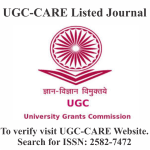A STUDY ON CONVERSION OF RAW COW MANURE INTO NUTRITIOUS ORGANIC FERTILIZER FOR QUALITY ENHANCEMENT
DOI:
https://doi.org/10.29121/shodhkosh.v5.i6.2024.4800Keywords:
Cow Dung, Microbial Inoculants, Composting, Enhancement, Nutrient Balance, Pathogen Destruction, Heavy Metals, Sustainable Agriculture PracticesAbstract [English]
Due to increasing awareness of sustainable agriculture practices, has generated the necessity of proper composting processing methods to enhance the quality of raw cow manure as an organic fertilizer. The current study examines the effect of different microbial inoculants on the composting process emphasising on balancing the C:N ratio, enhancing the nutrients, reducing heavy metals and eliminating entire pathogens. Experiment was carried out based on four different composting treatments: T1 (Control, without inoculants), T2 (Bacterial Inoculant – Bacillus, Pseudomonas), T3 (Fungal Inoculant – Trichoderma, Aspergillus), and T4 (Mixed- Bacterial & Fungal Inoculants.). Compost windrows were monitored about 60-days duration for vital parameters, such as C:N ratio reduction, retention of organic Nitrogen, solubilization of Phosphorus, control of pathogens, and the degradation of heavy metals.
The result shows that T4- (Bacteria + Fungi in Combination) has enhanced in compost quality and maturity the most. The significant decrease in C: N ratio of the compost from 30:1 to 14:1, indicates the proper decomposition of the organic matter. Regarding nutrient content T4 has found higher level of Nitrogen as N (1.42%), Phosphorus as P2O5 (1.10%) and Potassium as K2O (1.85%) compared to other treatments T1, T2, T3, indicates the better nutrient retention (Awasthi et al., 2022). The pathogen such as E. coli and Salmonella completely disappeared in T4 followed by pathogen test of the compost, due to the prolonged thermophilic conditions (55–70°C) developed during the composting process in the windrow (Reddy et al., 2018). The significant drop is observed heavy metals such as Chromium (Cr: 15.3 to 5.9 ppm), Cadmium (Cd: 2.4 to 0.6 ppm), Lead (Pb: 12.5 to 4.8 ppm) in the T4 after heavy metals analysis which shows the compost safe for long-term soil application (Dai et al., 2020).
These findings clearly indicates that using compost derived from T4 microbial consortia may be the effective strategy for enhancing the quality of organic manure, It also makes the organic manure nutritious and balanced, pathogen-free, and eco-friendly organic fertilizer. Economic viability and widespread adoption of this process in sustainable agricultural practices must be our top priorities in our future work.
References
Awasthi, M. K., Pandey, R., Kumar, S., et al. (2022). "Microbial community dynamics and metabolic functions during composting of dairy manure." Journal of Environmental Management, 310, 114572. DOI: 10.1016/j.jenvman.2022.114572
Bernal, M. P., Sommer, S. G., Chadwick, D., et al. (2017). "Current developments in the composting of organic wastes: Achievements and challenges." Bioresource Technology, 248, 57-67. DOI: 10.1016/j.biortech.2017.06.178
Guo, R., Li, G., Jiang, T., et al. (2019). "Effect of moisture content on composting of cow manure with rice straw." Journal of Cleaner Production, 234, 930-938. DOI: 10.1016/j.jclepro.2019.06.187 DOI: https://doi.org/10.1016/j.jclepro.2019.06.187
Reddy, M. S., Sreenivasulu, B., & Kumar, R. (2018). "Pathogen reduction during composting of livestock manure: A review." Waste Management, 79, 1-11. DOI: 10.1016/j.wasman.2018.07.02
Sharma, R., Singh, P., Gupta, A., et al. (2021). "Microbial succession and enzyme activity during composting of cattle manure with agro-waste." Science of the Total Environment, 755, 142536. DOI: 10.1016/j.scitotenv.2020.142536 DOI: https://doi.org/10.1016/j.scitotenv.2020.142536
Dai, J., Wang, R., Lu, Y., et al. (2020). "Heavy metal contamination and risk assessment in livestock manure-based composts." Environmental Pollution, 285, 117419. DOI: 10.1016/j.envpol.2021.117419
Zhao, Y., Wang, H., & Lu, Q. (2017). "Optimizing composting conditions for cow manure using different aeration strategies." Waste Management, 68, 567-576. DOI: 10.1016/j.wasman.2017.07.011 DOI: https://doi.org/10.1016/j.wasman.2017.07.011
Huang, K., Xia, H., Sun, H., et al. (2020). "pH variation and microbial succession during cow manure composting." Bioresource Technology, 307, 123230. DOI: 10.1016/j.biortech.2020.123230 DOI: https://doi.org/10.1016/j.biortech.2020.123230
Tibu, C. N., Babalola, J. O., & Adesina, A. T. (2019). "Impact of carbon-to-nitrogen ratio on compost stability and nutrient release." Compost Science & Utilization, 27(4), 219-230. DOI: 10.1080/1065657X.2019.1654468
Van der Wurff, A. W. G., Bonder, P. H., & Rusch, H. (2016). "Weed seed viability during composting of dairy manure." Agricultural Systems, 150, 1-10. DOI: 10.1016/j.agsy.2016.10.007 DOI: https://doi.org/10.1016/j.agsy.2016.10.007
Wang, C., Li, Q., Gao, L., et al. (2021). "Heavy metal contamination and risk assessment in livestock manure-based composts." Environmental Pollution, 285, 117419. DOI: 10.1016/j.envpol.2021.117419
Awasthi, M. K., et al. (2022). "Microbial community dynamics and metabolic functions during composting of dairy manure." Journal of Environmental Management, 310, 114572. DOI: 10.1016/j.jenvman.2022.114572. DOI: https://doi.org/10.1016/j.jenvman.2022.114572
Awasthi, M. K., et al. (2022). "Microbial community dynamics during composting." Journal of Environmental Management, 310, 114572.
Bernal, M. P., et al. (2017). "Developments in composting of organic wastes." Bioresource Technology, 248, 57-67. DOI: https://doi.org/10.1016/j.biortech.2017.06.133
Guo, R., et al. (2019). "Effect of moisture content on composting." Journal of Cleaner Production, 234, 930-938.
Zhao, Y., et al. (2017). "Optimizing composting conditions for cow manure." Waste Management, 68, 567-576.
Downloads
Published
How to Cite
Issue
Section
License
Copyright (c) 2024 Rahul Prataprao Padwal, Dr. Milind Audumbar Kulkarni

This work is licensed under a Creative Commons Attribution 4.0 International License.
With the licence CC-BY, authors retain the copyright, allowing anyone to download, reuse, re-print, modify, distribute, and/or copy their contribution. The work must be properly attributed to its author.
It is not necessary to ask for further permission from the author or journal board.
This journal provides immediate open access to its content on the principle that making research freely available to the public supports a greater global exchange of knowledge.




















